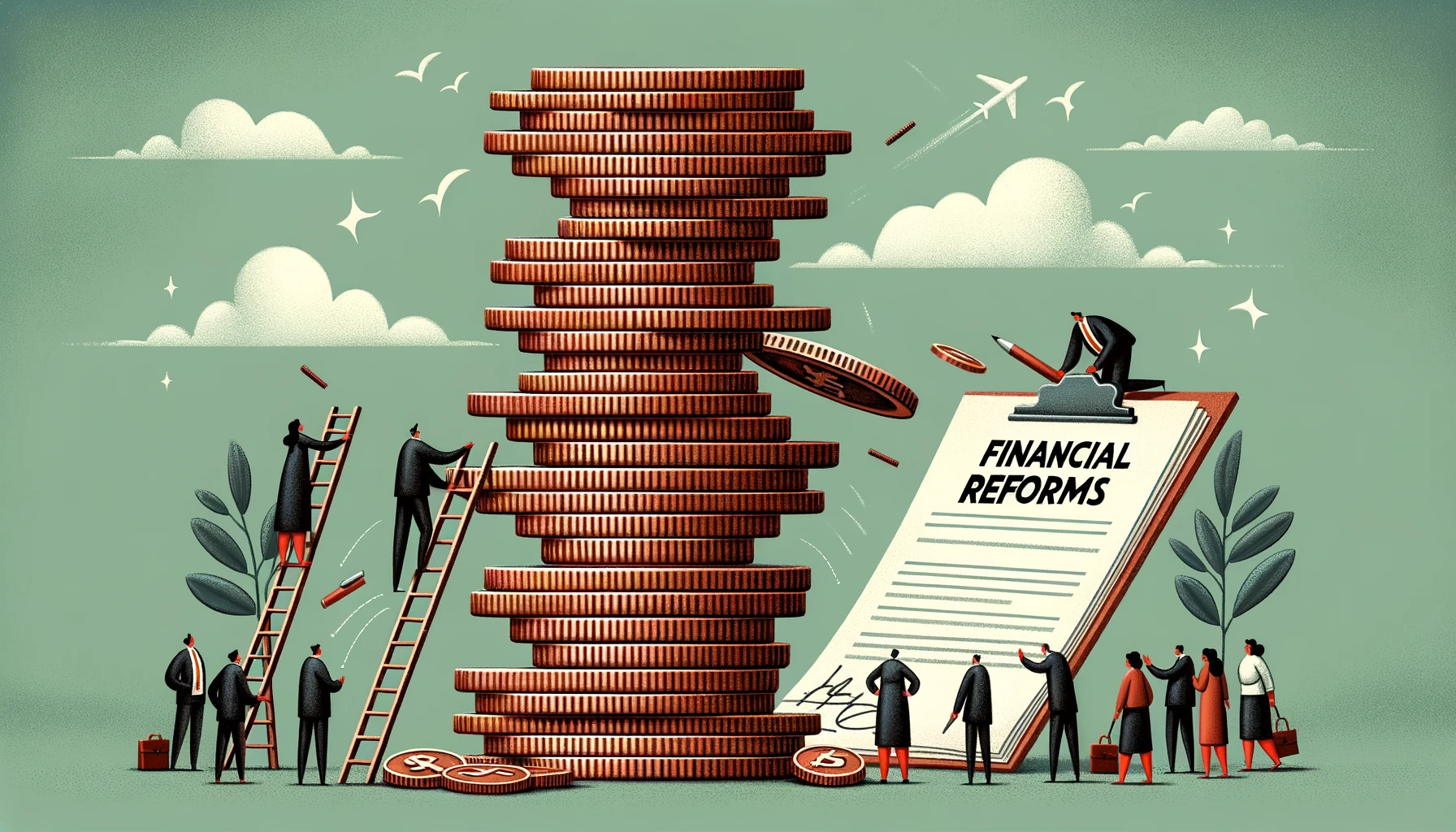The Financial Recovery Plan of Saade Chami lays the foundation for containing Lebanon’s economic crisis. The promising aspects of the Plan are that it respects the hierarchy of liability through a distribution of losses, aims to unify the exchange rate, and looks to encourage economic growth through productive sectors. The Plan, in its overall form, appears to solve Lebanon’s financial crisis, but a closer look reveals that the plan is merely a tool developed by the politico-financial elite to preserve their own interests at the expense of depositors’ savings. The Plan fails to justly protect depositors and to hold accountable those responsible for the ongoing meltdown.
I. INTRODUCTION
The financial recovery plan (FRP) of 09/09/2022 drafted under the leadership of Deputy Prime Minister Saade Chami was produced as a rescue plan to contain the current crisis, restore stability, and delineate specific economic reforms to spur growth. The Plan at the outset also aims to unlock the IMF reform package to jump-start the economy.
The FRP’s 6 main objectives are the following:
- Improve the financial situation in the medium term while considering state owned and public state enterprise reform,
- Address the losses incurred by the financial sector through a fair hierarchy of claims,
- Restructure the banking sector to resume its role in financing the private sector as a major driver of economic growth,
- Shift the focus of monetary policy towards maintaining price stability,
- Restore social wellbeing,
- Ensure that governance, accountability, and transparency are applied within the management of public affairs.
The above objectives span over four sections tackling macro-economic, financial, structural, and private sector reforms. This position paper covers the first section on financial reforms given that other sections are contingent on the macro-economic section.
The FRP estimates the financial sector’s losses to be around 72 billion USD. Indeed, it considers that BDL is unable to return such a considerable amount to the commercial banks, while the latter do not possess the capital reserves to guarantee depositor money at their original value. Therefore, the plan’s ambitious objectives are needed to implement macroeconomic and institutional reforms in order to protect and compensate depositors.
The FRP relies on economic growth and improved tax collection to finance the fiscal gap. The FRP also aims to protect some depositors, echoing IMF principles. The FRP is therefore clear on addressing the financial losses through a “bail-in” and a return to accountability. The FRP, therefore, adopts the total loss absorption capacity (TLAC) framework, an international standard which aims to achieve a fair distribution of losses, and highlights the banks’ responsibility in the financial meltdown and the necessity for banks to declare bankruptcy. Nevertheless, protecting and compensating depositors through a “bail-in” has led the Association of Banks in Lebanon (ABL) to conduct a fierce opposition campaign against the government’s Plan to protect their own interests.
This position paper analyses the plan’s components, delineates its loopholes and avenues for abuse of power, and lists suggestions for sustainable and equitable economic reforms.
II. ANALYSIS OF COMPONENTS
1. Protection and compensation of depositors and the adoption of a fair distribution of losses
The FRP stipulates the protection of deposits up to a 100 000 USD and lays out a progressive compensation framework for large depositors. The plan also emphasizes the need to audit and determine commercial banks’ losses and financial standing. The plan therefore assigns the Banking Control Commission (BCC) alongside a renowned international company to determine each bank’s capital needs, starting with the largest 14 banks. Consequently, the plan adopts a waterfall of losses similar to TLAC: The banks’ shareholders capital will be wiped out first to absorb the bank’s losses to the greatest extent. The second tier of responsibility falls on large depositors. Thereafter, banks that are unable to cover the losses will be either merged with other viable banks or completely liquidated. Existing or new shareholders should inject capital[1] into surviving banks, and the failure to increase capital would lead to a bank being diluted and/or having to merge with another viable bank. The difference between the FRP’s waterfall of losses and TLAC is the absence of clawbacks—recovery of money that had been paid to an employee in response to misconduct—that compel the bank’s management to pay compensation and penalties for discharging their corporate duties inadequately.
2. Unification of the exchange rate
The plan acknowledges that one of the main factors that caused the financial crisis was the costly maintenance of the overvalued official lira peg. Currently, the multiple exchange rates employed throughout the country have resulted in the obstruction of economic growth though price discrepancies on the market. Therefore, the plan rejects the illegal multiple exchange rates and calls for a uniform floating rate as an essential step towards financial stability.
The plan suggests to base the unification process on the Sayrafa platform, and to regularly update the platform to accurately reflect the market rate. The plan also calls for a limited intervention of BDL on defining the exchange rate to avoid unjustified fluctuations in the exchange rate.
The presence of a multiple exchange rate is illegal and leads to distortions in market prices and economic activity. Therefore, the unification of numerous exchange rates is a step towards financial reforms, stabilization of market prices, and restoring customers’ purchasing power. The unification of the exchange rate is also a prerequisite to unlock IMF funds.
However, Sayrafa is managed by the BDL[2]. Consequently, BDL and the BDL governor would have the authority to influence the exchange rate. Since the creation of the Sayrafa platform, BDL has consistently set the exchange rate well-below market rates, setting a dangerous precedent. Additionally, setting the Sayrafa rate as the benchmark for the US dollar to lira exchange rate is illegal. According to Articles 2 and 229 of the Code of Money and Credit number 13513 dated 1/8/1963, the jurisdiction of assigning the exchange rate is exclusively set by the parliament and cannot be enforced by the Central Bank’s circulars. Therefore, the plan’s intent to unify the exchange rate is undermined by illegal processes that could preserve BDL’s hegemony over determining the exchange rate, setting a dangerous precedent.
3. Filling the financial hole through improved tax collection and economic growth
The FRP refutes the sale of state assets to cover the financial gap and relies on improved tax collection and economic growth to cover the losses.
The plan encourages a unified customs Value Added Tax (VAT) that is determined in relation to a unified exchange rate. The plan also encourages increased customs tax collection coupled with a more transparent disclosure of the value of imported goods. The plan also preserves the current tax obligations of companies at 17% (compared to the international average of 20%), in effort to encourage foreign investments and spur local growth.
The FRP also broadens the state’s real estate revenues through a tax on vacant properties and real estate illegally trespassing marine property, adjusting the real estate sale fee to 3% of the real value, and modifying the real estate registration fee. In fact, local authorities incur substantial losses in revenue by exempting vacant real estate from taxation.[3] Lifting the vacancy tax exemption would encourage property owners to lease or sell unoccupied property, discourage the practice of land speculation, and result in a more affordable housing market.
Enforcing taxes on the encroachment of marine property would allow Lebanese authorities to crack down on violators of maritime property and collect much-needed tax revenues. The plan also advocates for rigorous tax investigations and the prosecution of tax evasion – a much-needed initiative to cover the budget’s losses. Additionally, the plan proposes changes to income tax collection. Specifically, the plan aims to increase the taxpayer base by 10% annually over the next three to four years, but fails to specify a mechanism of implementation.
The FRP calls for the cancelation of tax exemptions including exemptions on VAT and customs (excluding essential goods), private schools, colleges, and universities, exemptions of Middle East Airlines (MEA)’s open skies policy, exemption from income tax granted to specialized and long-term credit banks and investment banks (Legislative Decree No. 50 of 15/7/1983), and the exemption for the assignment of shares in Lebanese joint stock companies (tax refund loophole).
The FRP encourages to cover financial losses through economic growth alongside improved tax collection. The plan stipulates to audit public institutions to evaluate the option of a public-private partnership in order to improve performance or to completely liquidate the public institution if deemed unviable. The plan also proposes privatizing the management of public institutions on a contractual basis through a ‘transparent’ bidding process to increase efficiency and consequently increase state revenues.
Reduction of public debt to GDP ratio
The plan mentions undergoing serious negotiations with foreign creditors to restructure foreign debt after reaching an agreement with the IMF. The plan stipulates reducing the debt to GDP ratio by 100% in 2026, and by 75% in 2032. The plan deems this steep public debt reduction as easily achievable since the debt is denominated in the undervalued LBP. For instance, the current debt stands at 95 billion USD (455% of GDP) at the exchange rate of 1500LBP per USD. The different debt categories in the overall 95 billion USD debt include: 33 billion USD in foreign currency as Eurobonds, and 62 billion USD at the official LBP exchange rate – both of which are subject to debt restructuring, while the last category composed of 3 billion USD is not subject to debt restructuring. When adopting the black-market exchange rate, 30 000LBP per USD for example, debt subject to restructuring falls now at 36 billion USD, or at 173% of GDP. Considering the current exchange rate of 40 000 LBP to the USD, debt subject to restructuring falls at around 35 billion USD, or 168% of GDP. The fact that debt-to-GDP is not measured without specifying the exchange rate, or the fact that GDP is not measured in a timely or accurate manner means setting the debt-to-GDP down at 75% is facetious, at best. Indeed, because this target is also the basis for how the deposit recover fund will function (see below), the manipulation of this rate could easily be used to avoid paying back depositors. Moreover, the widespread nature of the cash economy and informality has not been acknowledged or accommodated, further underling the lack of seriousness with regard to, for instance, raising the tax base by 10%.
Besides debt restructuring, the plan relies on national economic growth as mentioned above to further reduce the debt to GDP ratio. The plan also stipulates that another way to reduce overall debt is by issuing perpetual bonds from the government to BDL valuated at 2.5 billion USD.
What the plan also fails to mention, however, is that most of the Eurobonds held by local commercial banks have been sold off to foreign creditors (vulture capital firms), which have to agree in full to a restructuring of Eurobond debt. Given the lack of incentive among vulture capital firms to allow for restructuring, the accumulated debt of this portion of the public debt—which is the most important—cannot be calculated accurately. Furthermore, confidence in Lebanese public debt will not be restored until negotiations with foreign creditors are settled. The omission is glaring and means that the intention seems to be to kick the debt can down the road.
4. Discerning between eligible and non-eligible deposits
The plan ambiguously discerns between eligible and non-eligible deposits and designates the BDL and BCC to define the difference between the two. The plan only mentions deposits that have been converted from LBP to USD at the official exchange rate after October 2019 are excluded from qualifying for compensation, and therefore fall under the “non-eligible” category.
The plan also excludes the surplus revenue accrued on interest since 2015 on deposits exceeding 100 000 USD. It is noteworthy to highlight a discrepancy between the FRP and the draft law governing the resolution of banks, where the latter limits the definition of ineligible deposits to those converted into foreign currencies post-October 17, 2019 and defines eligible deposits as the rest of the deposits in foreign currencies. Additionally, prime minister Najib Mikati defines non-eligible deposits in an interview as LBP deposits that were converted to USD at the 1500 official exchange rate after October 2019, estimated to be around 30 billion USD.[4]
Additionally, the plan is unclear on the compensation mechanisms for LBP accounts. The plan only accounts for the compensation of USD accounts and leaves out LBP deposits without specifying any remuneration mechanisms or rate.
5. Ambiguous protection of depositors
The FRP stipulates that a large part of the Central Bank’s foreign currency obligations to banks will be cancelled in order to reduce the deficit in BDL’s capital. As a compensation, BDL will issue warrants to the creditor banks. The BDL defaulting to pay back its debt to commercial banks will decrease the latter’s monetary capacity, and consequently, will decrease the banks’ ability to pay back depositors’ money in full value. Therefore, the FRP will not be able to fully protect depositors’ money.
The plan also stipulates the guarantee of deposits to a threshold of 100 000 USD. The FRP notes that the protection of deposits up to 100 000 USD could be compensated either in LPB or USD, or a combination of both. However, compensation will depend on each bank’s solvency. Therefore, not all 100 000 USD deposits will be remunerated without a financing from the central bank. The plan consequently leaves the compensation of 100 000 USD deposits purely up to each bank’s capacity to settle accounts with depositors. However, the prime minister Najib Mikati confirms in the interview referenced above that deposits below 100 000 USD will be compensated in full, by a breakdown of 50% in LBP at the black-market rate, 25% in USD from the BDL, and 25% in USD from the commercial bank in which the money is deposited.
In addition, the plan is unclear on the merging of accounts across banks, or the timeframe for when deposits will be paid back.
Also, the plan claims to protect deposits for up to 100 000 USD but excludes balance increases that occurred after 31 March 2022. Hence, wealth accumulated by depositors after 31 March 2022 will not be protected.
The plan also suggests to lirify the USD deposits in viable banks to cover the banks’ losses. The lirafication of USD accounts is not only illegal but also wipes out the value of depositors’ savings.
6. The Deposit Recovery Fund (DRF)
In the same regard, the plan calls for the establishment of a Deposit Recovery Fund (DRF) run by an independent private sector entity in which depositors have a ‘primary role,’ without specifics. However, the draft law aiming to rebalance the financial sector in Lebanon stipulates that the management and structure of the DRF will be determined by the Council of Ministers based on the Minister of Finance’s recommendation. The Council of Ministers will appoint a so-called independent body of specialists for the management of assets of the DRF. The stated primary objective of the Fund is to secure the recovery of the largest possible number of deposits that exceed 100 000 USD in a timely manner.
The DRF will allegedly be funded through the recovery of illegal capital flight that occurred after October 2019, deposits whose legal origins cannot be accounted for, partial transfers of commercial bank assets and deposits, and through certificates of deposits in BDL. The FRP also stipulates the transfer of surplus revenues generated from state assets to feed the DRF and compensate depositors.
The transfer of surplus revenues from state assets to the DRF will occur after achieving unspecified rates of growth, ensuring the sustainability of public debt, and providing basic services to citizens. Hence, the plan stipulates to reorient revenues from public institutions when the state is able to maintain a “decent” level of social wellbeing and infrastructure, and after bringing the public debt below the prospective target. Therefore, to guarantee a sustainable funding of the DRF and compensate large depositors (>100 000 USD) in a timely manner, the recovery of illegal wealth and illegitimate capital flight should occur immediately, while heavily reforming and deploying funding to public institutions. Of course, asset recovery is one of the longest and most complicated financial procedures, given that it involves the cooperation of several jurisdictions and often takes decades to recover only partial funds. However, the FRP does not define the “decent” level of spending on infrastructure and does not mention how the level will be determined as a share of GDP.
Therefore, the DRF could likely move towards focusing on correcting the public debt and its subjective investment in infrastructure to ensure the so-called “decent” level of spending, rather than compensation of depositors in a timely and urgent manner.
Hence, the plan relies on revenues of public state assets to compensate large deposits. It is noteworthy that the exploitation of state assets to cover the losses of the banking sector coincides with the ABL’s request to use state assets to finance the losses.
7. Weak accountability mechanisms
Although the plan adopts the principle of the TLAC approach to initiate a waterfall of losses and orderly distribution of losses, the plan does not hold accountable those responsible for orchestrating the financial meltdown. The plan excludes the responsibility of the state, BDL governor, those behind the shadow financial plan, and well-connected individuals who transferred their money outside the country amidst the informal capital controls placed on the general public.
The plan also does not hold accountable private companies that shrunk the value of their employees’ salaries through the payment of ‘lollars’ whose real value was far below the enumerated value.
RECOMMENDATIONS
Protection and compensation of deposits
Forced conversions of depositors’ money from USD to LBP at a devalued rate must not be accepted and lirafication of foreign currency deposits cannot be used as means to cover the banks’ losses. Forced conversions to fund the failure of bank management should be refuted for all accounts, whether the account is below or above 100,000 USD.
The protection and compensation of small depositors should be capped at 250 000 USD instead of 100,000 USD. This protection level fails to fall in line with the position outlined by progressive MPs pre-election or the Depositors Union, which set the protection level at 250,000 USD – incidentally the deposit insurance level set by the US Federal Deposit Insurance Corporation (FDIC).
The protection floor should also be fixed and guaranteed without linking the threshold to a bank-by-bank capacity, or on any arbitrary date for return of deposits.
USD deposits should also be paid back in the same currency, and not in LBP. Compensating depositors in LBP instead of USD risks the devaluation of their savings, and increased liquidity which will destabilize the exchange rate.
Additionally, the FRP needs to specify a compensation scheme for LBP deposits, as LBP accounts are completely disregarded within the plan. LBP account holders who saw their savings evaporate through inflation must also be protected.
Inclusion of clawback provisions to finance the banks’ losses
A myriad of dreadful bank management decisions should be accounted for. Clawback provisions impose financial accountability on key decision-makers within banks and compel bank management (board of directors and senior staff) to pay compensation and penalties for negligent decision making and disregarding their fiduciary duties, even after their tenure is over. Therefore, clawback provisions must be implemented in line with the bail-in framework established by TLAC and clawback provisions of the Basel Commission on Banking Supervision (BCBS) rules. The money recouped from this process should then be allocated as an additional stream of capital to meet the bank’s losses and most importantly to compensate large depositors as much as possible for the haircut on their deposits.
Clawback provisions will also need to be legislated by parliament and implemented by the BDL through circulars. Legislatively enshrining clawbacks as a mandatory requirement in the BDL and commercial banks’ oversight structure would ensure that banks’ management would avoid illegal behaviour or otherwise face severe financial penalties. Additionally, clawbacks would offer an additional stream of capital to finance potential future losses within the banking system, and help restore depositors’ trust in the banking sector.
Eligibility of depositors
Discerning between eligible and non-eligible deposits should be based upon the legitimacy of depositors’ source of wealth. If the latter cannot be justified, it is not eligible for compensation. Through the removal of banking secrecy, the source of large depositors’ money can and should be audited to determine their eligibility for compensation, while unexplained wealth and profits under financial engineering schemes can be put towards the deposit recovery fund. Therefore, depositors, specifically those with deposits above 250,000$ should be required to provide the necessary evidence (documentary paperwork) to prove that the source of their wealth is legal. An independent body of specialists should lead on such investigation, and deem that any profits accumulated from illegal, smuggled, or stolen sources of wealth are not to be covered by the DRF.
The DRF’s governing body
The FRP does not stipulate a clear mechanism to determine the makeup of the DRF’s governing body – an independent private sector entity. This lack of specificity provides too greater leeway for political influence in the makeup of the DRF. Instead, a joint international board should be established to ensure the highest level of transparency and independence. There must be a rigorous list of criteria to be met in order to be in such a body including extensive specialist knowledge, no connections to any Lebanese political parties or interests, and no ties to any of the banks, their management, or employees, currently under investigation.
Defining the exchange rate
The exchange rate should be a managed unified float defined at the parliamentary level as per Lebanese laws, and not through the dictates of the BDL or MOF. A managed float allows for a corridor exchange rate range to be determined in order to avoid over-valuating and under-valuating the national currency will be needed in the medium term. Only after that adjustment period should Sayrafa, which is currently illegal, be used as an instrument to unify exchange rates with the intention of a long-term managed float of the currency.
Accountability mechanisms
The FRP should hold the state, the BDL, and the BDL governor accountable for the financial liabilities, and for draining the country’s foreign exchange reserves. The plan, in its current form, lays the burden of the losses on banks, without accounting for the state or central bank’s responsibility in failed financial decisions. The plan should also hold the private companies responsible for the forced lirafication of their employees’ salaries without any form of compensation.
Transparent Public-Private Partnership
The FRP needs to outline and specify a transparent bidding and management process with regard to the competency and expertise of private sector companies that will manage public institutions. This bidding process and management structure should limit nepotism and sweetheart deals of the politico-financial class by managing such processes through (yet to be established) independent regulators instead of ministries and/or the CDR.
Towards more progressive taxation
The FRP states the need to reform the current income tax collection system to finance the state’s losses. While most of this approach is encouraging, the lack of specificity around key reforms means reform of the tax system lacks seriousness. For instance, there is no mention of how tax brackets to improve progressive taxation would be amended. At present, the top tax tier for income taxes is around 25%, compared to the OECD average of around 40%. Furthermore, without adopting a “the whole of revenue”—whereby individual taxable income includes all types of revenues, from wages and salaries to capital gains, dividends, interests, property and land incomes, commercial and professional revenues, and the international capital income earned by residents—the total tax paid on personal income will likely be co-opted by savvy accounting. A wealth tax, either one time or progressive, is also notably absent from the FRP.
The FRP fails to specify the mechanism that will guarantee a more inclusive and efficient tax collection system. The FRP should therefore explicitly mention and outline the shift toward a more progressive tax system to reduce the fiscal deficit in a more socially equitable manner, list the mechanism to strengthen tax compliance, and broaden the tax base.
The plan stipulates a gradual introduction of VAT on basic goods, to reach an overall increase of 4% over an undefined period of several years. Increased VAT on basic goods should be refuted, as it would add unnecessary fiscal pressure on the most vulnerable households. The same applies for the effective increase in customs duties through the so called ‘customs dollar’ which increases the prices of goods across the board in an import-dependent country such as Lebanon.
[1] Creditor Update, June 2022, Lebanese Ministry of Finance.
[2] “Overview of the recent monetary, banking, and financial developments in Lebanon”, 2021, Banque du Liban.
[3] “Property Tax: No More Vacancy Exemptions”, July 2020, Mona Fawaz, Abir Zaatari, Lebanese Center for Policy Studies.




